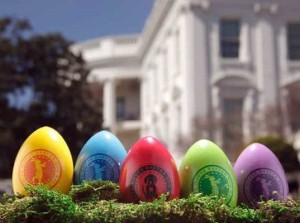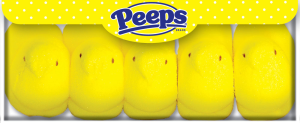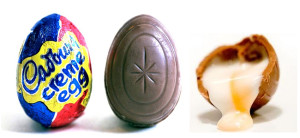There are so many traditions and custom celebrated during the Easter season. The origin and history of some the most famous events are listed below: the White House Easter Egg Roll and the New York Easter Parade. Also, check out some trivia concerning our favorite candies used to fill our Easter baskets: Peeps and Cadbury Eggs.
 The White House Easter Egg Roll
The White House Easter Egg Roll
In the United States there is an annual event held on the White House lawn the first Monday after Easter. In 1814, Dolley Madison, the wife of President James Madison, invited hundreds of children to bring their decorated eggs and join in games on the grounds of the United States Capitol. In 1877, when a new lawn was planted the event was cancelled. Subsequently, Congress passed a law making it illegal to use the grounds as a children’s playground. In 1878, President Rutherford Hayes brought the event to the White House but during Franklin Roosevelt’s presidency the tradition was abandoned and later to be revived by during President Dwight Eisenhower’s administration. The Egg Roll is a race where children push an egg through the grass with a long-handled spoon across the White House lawn. The event is attended every year by a large crowd of children and their parents invited by special invitation or selected by a lottery system. Activities include speeches, book readings, exhibits of decorated Easter eggs and appearances by the President and his family, members of Congress and even famous celebrities but the highlight is always the Easter Bunny.
SPECIAL NOTE: This famous American event was featured in a scene in the 2007 film, “National Treasures: Book of Secrets”.
The New York Easter Parade
Wearing new clothes for Easter has been a tradition since ancient times. The Pagans celebrated the vernal equinox with a celebration to honor Ostera, the Goddess of Spring, and they believed that wearing new clothes brought them good luck. In Christianity, during Easter many Christians were baptized and they wore white linen robes to symbolize rebirth and new life. The Roman Emperor Constantine declared that his court wear their finest new clothes in celebration at Easter. The tradition eventually evolved to mark the end of Lent, during a time when people would wear the same clothes for weeks, and finally would discard their old clothes for new ones.
Starting as a spontaneous, informal and unorganized event in the 1870s, the New York Easter Parade on Fifth Avenue quickly became an American cultural tradition on Easter Sunday. The event developed when the New York City churches would decorate their sanctuaries with elaborate floral displays for Easter. After church, the wealthy New Yorkers, dressed in their new, fashionable clothing with the women wearing their elaborate hats, would try to impress each other with their finery as they stroll down Fifth Avenue walking from one church to the other to see the impressive floral displays.
Over the years, the annual Easter Parade became an important event on the New York social calendar. By 1900, merchants and milliners began to link their advertisements to the event in hopes of increasing their retail sales. Not everyone was comfortable with these displays of wealth and extravagance. Comparisons were made to bring attention to the hardships and working conditions of the sweatshop employees who produced the wealthy consumer’s Easter finery. During the Great Depression, unemployed workers paraded in their worn clothing and carrying banners that called attention to troubles. It was pointed out that the cost of a single elaborate gown was equal to a year of welfare for an unemployed worker and their family.
By the mid-20th century, any connection to the religious aspects of the Easter parade had faded. The community event had changed from a parade of refinement based in a religious celebration to become a reflection of the American’s new idea that a person’s choice of clothing was only linked to their status and wealth. The decline in attendance continued until the New York Easter Parade became associated with outlandish and tasteless costumes becoming a satirical comment on the parade’s former focus.
A traditional Easter treat, Peeps are marshmallow candies sold in the shape of chicks or bunnies. They are produced by the Just Born candy company founded in Bethlehem, Pennsylvania. They are made from marshmallow, corn syrup, gelatin and carnauba wax. The yellow chicks, appropriately named Peeps, were originally created individually by hand until eventually this process was replaced by mass production. Peeps were originally sold only seasonally to use in Easter baskets but have since expanded to include other holidays, such as Valentine’s Day, Halloween and Christmas. The Peeps line has also expanded to include items such as lip balms, jewelry, fashion apparel and home accessories. In 2009 the first Peeps & Co. store opened in Bethlehem, Pennsylvania with additional stores following in two other locations, Maryland and the Mall of America in Minnesota. Their products are also available online at their website, www.peepsandcompany.com
Cadbury Crème Egg is a delicious blend of a thick milk chocolate shell in the shape of an egg with a white and yellow fondant filling that is created to resemble the yolk of a real egg. Crème Eggs are made by Cadbury UK and at the factory in Birmingham 1.5 million are made per day. The Cadbury Brothers have been making filled eggs since 1923 but the Crème egg with its seemingly realistic egg yolk was introduced in 1963. In the United States the Hershey Company has the marketing and distribution rights. Over the years, Cadbury had introduced other related products such as: the Caramel Egg which is a chocolate egg with a caramel filling, the Chocolate Crème Egg with chocolate fondant filling, the Orange Crème Egg similar to the original but with an added orange flavor and the Mint Crème Egg with a green colored yolk and a mint flavored chocolate.
You may be wondering … how do they create these unique Easter treats? The Cadbury Crème Eggs are created as two half chocolate egg shells, each is filled with white fondant and then a smaller amount of yellow fondant is added. Both halves are joined together and as they cool the two chocolate pieces bond together to form one whole egg. The eggs are then removed from the molds and wrapped in foil.
I hope you enjoyed this Easter trivia and maybe it will give you have some interesting facts for conversation at Easter lunch or dinner.
Happy Easter from the Enchanted Manor!



Knowing this list of trivia facts will help answer Easter trivia questions, amaze your friends, and add to your knowledge of this interesting celebration.
Thank you for your comment